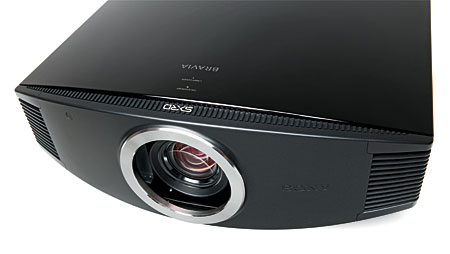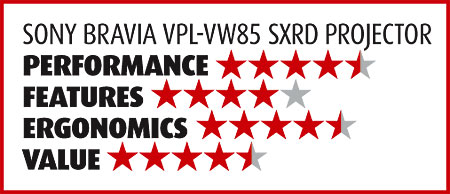Sony BRAVIA VPL-VW85 SXRD Projector Page 3
It was only in such an extreme situation that I noticed even the slightest downside to the Sony’s dynamic-iris-enhanced blacks. The projector’s shadow detail was also exceptional, and it sailed through all of my favorite black level/shadow detail tests, including the most challenging scenes from Stargate: Continuum, Master and Commander: The Far Side of the World, Spider-Man, and the new Blu-ray release of Battlestar Galactica.

Once calibrated, the Sony’s colors appeared as close to ideal as possible. Fleshtones were as flawless as the source would allow. Greens could look a bit ripe on occasion, but the measurements say they’re right on the money. Apart from slightly undersaturated greens, all the colors were spot on in the Normal setting of the color space control (see HT Labs Measures). The three Wide settings will let you tart up the colors if that’s your preference, but they won’t be accurate. I’d stick to Normal or, if you must, the relatively subtle enhancement that Wide 1 provides. The Normal setting never let me down.
Out of the box, the convergence of the three colors on the screen was as tight as any I’ve seen in a three-chip projector. There was some very subtle red misalignment in areas far from the center, but it wasn’t enough to affect the image or mess with the zone-panel alignment feature. My only complaint about the latter is that you have to use it with a crosshatch test pattern in the projector. You can’t use an external source to make the adjustments.
As shown in the Video Test Bench chart on the previous page, the Sony’s video processing was good, apart from our HD motion adaptive test. This was noticeably better, though still a marginal fail, with the Film mode off.
With the panel alignment feature engaged, the projector produced an obvious pink discoloration on maximum-resolution HD luma test patterns. This behavior is common in LCOS projectors to some degree, and turning panel alignment off mitigated the issue to the point of being typical of LCOS. But it’s important to note that even when panel alignment was on, this did not appear to affect normal program material in any way.
I can’t recall another projector I’ve reviewed that produced better resolution than the VPL-VW85. And it was this superior resolution I first noticed when I fired it up. White lettering on titles was clear and crisp, without the trace of colored edges that often turns up on other projectors—a sign of panel misalignment, optical issues (chromatic aberration), or both. In fact, the Sony’s lens quality here appeared to be among the best.
One of the many discs I watched on this projector was The International, a reference-quality transfer. The stubble and weathered textures on the actors’ faces jumped off the screen. (In the current fashion, most of the good guys appear to never shave; the bad guys nearly always do. Apart from Naomi Watts, of course.) Long shots of even the most distant details were crisp. This is one of the best transfers I’ve seen recently, and the VPL-VW85 does it full justice.
My Stewart Studiotek 130 screen is a relatively small 78 inches wide, but I also experimented by zooming the image out to simulate a much larger screen. While this only allowed me to view the center of the image (about three-quarters of the total), it closely replicated what you would see on a 103-inch-wide screen. A bit of image depth was lost, and some minor transfer flaws in the sources were more obvious. However, apart from this, the Sony will be more than impressive even on a larger screen.
Conclusions
I could be curmudgeonly about the odd gamma in the auto iris settings and the nonintuitive RCP color management system. I could talk about the lack of a blue-only mode to better check the color and tint settings and the quality of the color decoder. But no video display is perfect. The important point is that Sony has continued to refine its SXRD projectors while holding the line on the price. The result is a great projector that, while not inexpensive, should be on your shopping list even if you’re willing and able to pay much, much more.

- Log in or register to post comments





























































